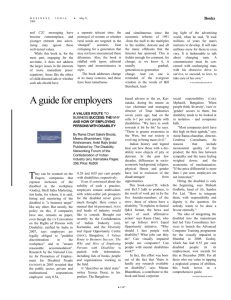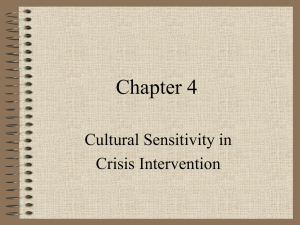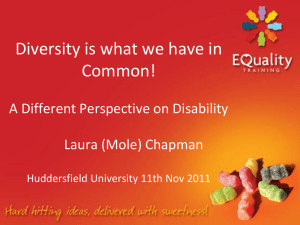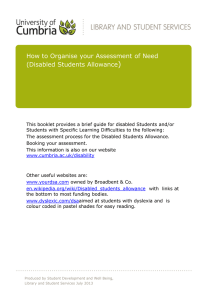Here is our latest briefing to the Minister of Social Development
advertisement
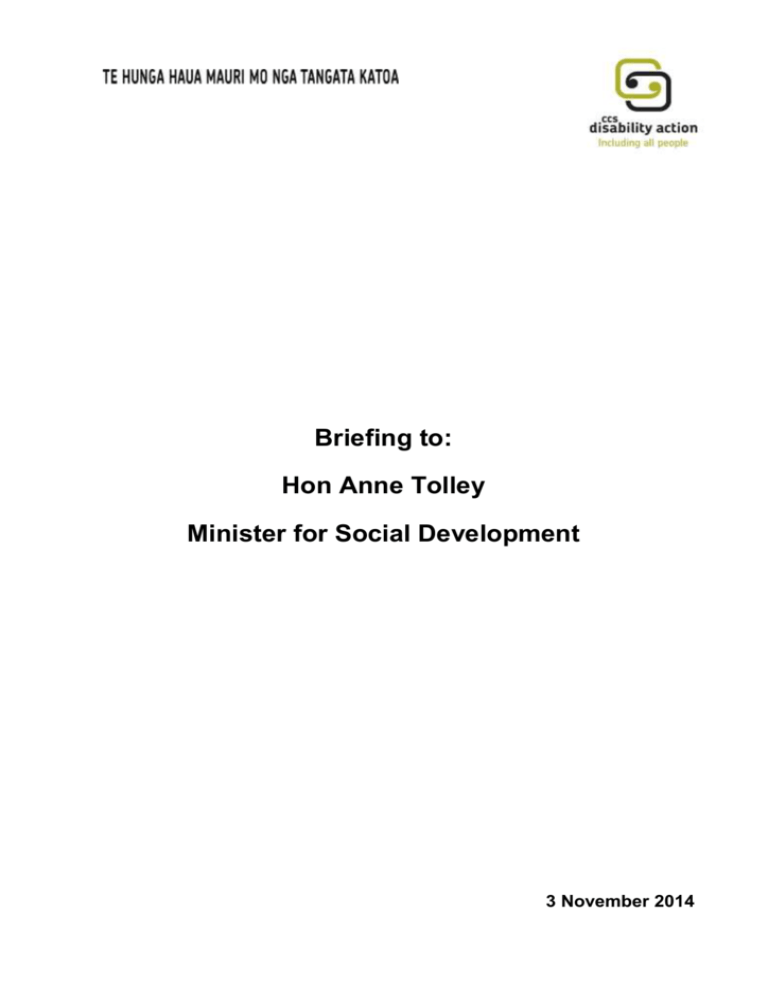
Briefing to: Hon Anne Tolley Minister for Social Development 3 November 2014 1 Contents Introduction .......................................................................................................................... 2 About us............................................................................................................................... 4 Disabled New Zealanders do not get a fair go ..................................................................... 5 Discrimination and employer attitudes 7 We need to change 7 What we can do 9 Lack of data 10 Recommendation ........................................................................................................ 10 Transparency and accountability leads to better policy development 10 Recommendation ........................................................................................................ 11 Enabling Good Lives and community organisations .......................................................... 11 Disabled children are amongst our most vulnerable children ............................................. 12 Disabled children are more likely to live in poverty 13 What can we do 14 Early Childhood Education, after school care and employment for parents of disabled children 14 Recommendations ...................................................................................................... 15 The Child Disability Allowance is out-dated 15 Recommendation ........................................................................................................ 16 Thank you .......................................................................................................................... 16 2 Recommendations CCS Disability Action recommends that: The Ministry of Social Development should use the Integrated Data Infrastructure to collect demographic, including employment statistics, on disabled people who use Ministry of Social Development and Ministry of Health disability related services. The Ministry of Social Development restarts the Statistical Report or includes information on supplementary benefits and allowance in its quarterly report. If a child needs a support worker to attend an early childhood centre, the hours should match the full 20 hours of free Education Childhood Education Out of School Care and Recreation (OSCAR) funding should be increased for children who require additional support. The Ministry of Social Development reviews and overhauls the Child Disability Allowance. 3 Introduction Congratulations on being appointed Minister of Social Development. As Minister of Social Development you play a vital role in ensuring disabled Our vision New Zealanders get a fair go. Disabled people are included in We want to share our knowledge with you. We do not the life of their community and have all the answers, but we can provide you with advice family. and analysis to help you make better decisions. It has never been more vital that disabled people in New Zealand are included in the community. With the aging population, the number of disabled people is set to increase. Already disabled people make up almost a quarter of the population. We are running out of time to create an inclusive society. Being included in the community means disabled people have equal access to education, employment, buildings, infrastructure and transport. People with disabilities need to have the same choices as non-disabled people, such as the choice of where to live and where to work. As Minister of Social Development, you have a key role to play in ensuring disabled people get a fair go in the community and employment. 4 About us CCS Disability Action is a community organisation that has been advocating for disabled people to be included in the community since 1935. We provide disability support to over 5,000 people with disabilities and their families and whānau each year. We receive a mixture of government funding and private donations. We run the Mobility Parking scheme which supports over 114,000 people to more easily access their local towns and facilities. Our fully owned subsidiary, Lifetime Design Ltd, advocates for and provides universal design guidelines to improve the accessibility of New Zealand housing, which will benefit all people throughout their life. Our governance has strong disabled leadership and many of our staff members identify as disabled. Our advocacy is evidence-informed, honest and responsible. What unites and drives our organisation is a common philosophy. We believe that the community should value and include disabled people. 5 Disabled New Zealanders do not get a fair go Too often disabled people do not get a fair go. They do not get the same opportunities as non-disabled people. Disabled people do not always have equal access to Some of the costs of exclusion education, employment, buildings, infrastructure and transport. Last financial year, the As a result, some disabled people are excluded from the Government spent over $2 employment and the community. billion dollars supporting people on disability related This is bad for disabled people and wider society. benefits. Disabled people aged 15 to Considerable money is spent on disability related services and 44 have an unemployment income support, but there is often poor outcomes for disabled rate of 14 per cent, people. compared to 7 per cent for non-disabled people. In the 2013 Disability Survey, disabled people; were less likely to report a high level of life satisfaction; were less likely to feel safe at home or in their neighbourhood; were twice as likely to be the victim of violent crime; more likely to report being discriminated against and more likely to be discriminated against more than three times over a twelve month period; more likely to have no qualification and less likely to have a bachelor's degree or higher; had higher unemployment and lower labour force participation; more likely to have lower incomes and live in lower income households, including for those aged under 65. We can do better and we must do better. A nation survives and thrives on how well it includes all its citizens in everyday life. 6 People reporting their life satisfaction - higher is more satisfied 80% 70% 60% 50% 40% Disabled people 30% Non-disabled people 20% 10% 0% 0–4.9 5–7.9 8–10 Highest qualification gained Disabled people Non-disabled people 37% 33% 32% 23% 25% 23% 15% No qualification 12% School qualification Post-school Bachelor's degree or at level 1 to 4 qualification at level higher 1 to 6 Total personal yearly income- aged 15+ 40% 35% 30% 25% 20% 15% 10% 5% 0% Disabled people Non-disabled people 7 Discrimination and employer attitudes In a 2012 survey of employers, 78% said they believed disabled people were discriminated against in employment. 59% felt there were barriers that might stop disabled people from being employed in their own workplace. Only 21% felt there were none. Most employer believed these barriers were either difficult to address or insurmountable.1 Nearly all the employer in the research showed, at least outwardly, positive attitudes to disabled people. Nearly all employers believed that disabled people deserved a fair go and that their low rate of employment was an issue. These positive attitudes, however, seemed to have no effect on their willingness to hire disabled employees. Neither did knowing disabled people or having positive past experiences employing disabled people. We need to change The discrimination and barriers people with impairments face are an issue for all of us. When disabled people are prevented from accessing the community and finding employment we all lose. With an aging population, the proportion of people in the labour force who have disabilities will increase. Exclusion costs us all. Statistics New Zealand’s median labour force projections has people over 65 making up 14 per cent of the labour force by 2036. In the 2013, Disability Survey people over 65 had a disability rate of 59 per cent, compared to 21 per cent of people aged 15 to 64. The future prosperity of New Zealand depends on our ability to include disabled people in education, employment and the community. 1 This research was sponsored through the Think Differently Campaign and can be found here: http://www.thinkdifferently.org.nz/employer%20research 8 Estimated percentage of labour force over 65 18% 16% 14% 12% 10% Estimated percentage of labour force over 65 8% 6% 4% 2% 2061 2056 2051 2046 2041 2036 2031 2026 2021 2016 2011 2006 0% Researchers from Canada have estimated that reducing the unemployment rate amongst disabled people could increase GDP per capita by up to $600 Canadian dollars per year. They also found that increasing the education achievement rate of disabled people would generate an additional boost to GDP of $200 Canadian dollars per year. 2 These estimates were in Ontario. Ontario is, arguably, more advanced than New Zealand in terms of accessibility and human rights. This suggests our gains could be even higher. 2 This research was commissioned by the Government of Ontario and can be found here: http://martinprosperity.org/2010/06/14/releasing-constraints-projecting-the-economic-impacts-of-increased-accessibility-inontario/ 9 What we can do The issues affecting disabled people are complex and Government alone cannot solve all the issues. Government, however, has a key role to play. Government funded services and income support play a major role in the lives of many disabled people. We need to find ways to include disabled people in the community and employment. As long as people with disabilities cannot freely access employment, education and the wider community, they, and New Zealand as a whole, will be significantly disadvantaged. This is a complex challenge. For example, these are just some of the issues stopping disabled people from finding employment: • attitudes of employers and fellow workers; • availability of suitable jobs in the local economy; • ability to make adjustments to the work place; • availability of flexible hours; • availability of formal and informal support networks; • a person’s access to education and work experience; • lack of accessible transport options and; • an inaccessible built environment. By addressing the root causes that stop people from finding employment, people may no longer require government services or may require less support. This results in better outcomes for the person and saves the government money. As an organisation, we have always recognised this. Even when we were established in 1935, we had a significant focus on improving employer’s attitudes towards disabled people and skill training. We largely fund this work through non-government funding. There are a range of initiatives underway and the Ministry of Social Development has a long-term work plan to address the low employment rate of people with disabilities. There are, however, some weak points, which may hold back progress. 10 Lack of data A major barrier to effective policy is the lack of reliable and frequent data on employment and disability. The only comprehensive data on employment and disability is the Disability Survey. The Disability Survey is only carried out with the Census, which means there is a gap of at least five years between surveys. This gap is too long for policy and target setting purposes. This means that the overall achievement of current initiatives is not adequately measured. We do not know if current government programmes and spending is actually getting more people with disabilities jobs. Statistics New Zealand is investigating ways to include disability in the Household Labour Force Survey and General Social Survey. The Ministry of Social Development should also be making better use of Statistics New Zealand’s Integrated Data Infrastructure. The Integrated Data Infrastructure would allow the Ministry to collect data on the employment statistics of disabled people who use Ministry of Social Development and Ministry of Health disability related services. 3 Recommendation The Ministry of Social Development should use the Integrated Data Infrastructure to collect demographic, including employment statistics, on disabled people who use Ministry of Social Development and Ministry of Health disability related services. Transparency and accountability leads to better policy development It is important that government is accountable. Last year, the Ministry of Social Development suspended the long-running Statistical Report. This limits the source of publicly available data on the welfare system, particularly for supplementary benefits and allowances. Government policy making resources are limited. One of the current focuses of public policy is on making better use of non-government resources. Non-government advice is especially good at identifying blind spots in policy development. The ability of nongovernment organisations to offer advice and help government develop good policies, 3 You can read more about the Integrated Data Infrastructure here: http://www.stats.govt.nz/browse_for_stats/snapshots-of-nz/integrated-data-infrastructure.aspx 11 however, relies on access to good accurate information. With good quality information, we can play a positive role in policy development. Recommendation The Ministry of Social Development restarts the Statistical Report or includes information on supplementary benefits and allowance in its quarterly report. Enabling Good Lives and community organisations We strongly support the direction of Enabling Good Lives. Disabled people need to have choice and control over the supports they receive. Choice is only meaningful however, if there are viable options to choose from. Community organisations still have a valuable role to play. Community organisations, like ours, often drive innovation in the disability community. We have a long history of innovation and strong connections to local communities, individuals and families. Alongside the continuing reforms, we plan to run a number of our own pilots next year. We will to continue to innovate and evolve to meet the needs of the people we serve. As Minister of Social Development, we encourage you to value and make use of the resources and knowledge long-standing organisations, such as ours, have. The best results are achieved by government working together with non-government organisations. . 12 Disabled children are amongst our most vulnerable children Disabled children are more likely to live in low-income households, have fewer rights in current Law and experience serious discrimination in access to education. Despite the barriers disabled children face, issues affecting them are seldom part of the public debate on vulnerable children. The 2013 Disability Survey also estimated that disabled children were less likely to have done the following activities, in the previous four weeks, than nondisabled children were: had music, art, or other similar lessons; played a team sport; done other physical activity such as swimming or gymnastics; visited friends; been away on holiday in last 12 months. Only 77.8 per cent of disabled children had visited friends, over the previous four weeks, compared to 92 per cent of non-disabled children. Overseas research has found that Disabled children are at a higher risk of abuse. One of the most comprehensive studies to date, which took place in America, found children with disabilities were, when compared with children without disabilities: 4 3.8 times more likely to be neglected; 3.8 times more likely to be physically abused; 3.1 times more likely to be sexually abused.4 See the American Academy of Pediatrics article below or the recent Health Committee Inquiry into improving child health outcomes and preventing child abuse. http://pediatrics.aappublications.org/content/119/5/1018.long http://www.parliament.nz/en-nz/pb/sc/documents/reports/50DBSCH_SCR6007_1/inquiry-into-improving-child-health-outcomesand-preventing 13 Disabled children are more likely to live in poverty Disabled children are more likely to live in poorer families. The 2013 Disability Survey found that 34 per cent of disabled children live in families that earn under $50,000 a year, compared to only 24 per cent of non-disabled children. 17.7 per cent of disabled children live in households that earn under $30,000 a year, compared to 11.5 per cent of non-disabled children. Five per cent of disabled children live in households that earn under $15,001 a year, compared to 3.8 per cent of non-disabled children. The Ministry of Social Development’s 2012 Statistical Report found that: 37.5 per cent of caregivers receiving the child disability allowance are on a main benefit or superannuation. Disabled children - household income Less than $15,001 $15,001–$30,000 $50,001–$70,000 $70,001+ $30,001–$50,000 5% 13% 49% 16% 17% Non-disabled children - household income Less than $15,001 $15,001–$30,000 $50,001–$70,000 $70,001+ $30,001–$50,000 4% 8% 12% 59% 17% You cannot address child poverty or child abuse without addressing the issues disabled children face. 14 What can we do The increased rate of poverty for disabled children is concerning. There are two basic ways to address the issue. Firstly, we need to support parents of disabled children to find and keep appropriate employment. Second, we need to ensure adequate support is available when it is unrealistic for the parents to work. Early Childhood Education, after school care and employment for parents of disabled children Currently, some parents are unable to find work, or work an adequate number of hours, because of inflexible policies. For example education support worker funding for early childhood education is limited to a maximum of 15 hours, with many disabled children getting far less. Educational support worker funding also does not continue through the holidays or for any longer than three hours a session. Some early childhood centres will deny a place for disabled children unless an education support worker is provided. This means parents cannot work more than a maximum 15 hours, or even use the full 20 hours of free Early Childhood Education. This makes it extremely hard for parents, particularly sole parents, to re-enter the work force. It is a short-sighted and grossly unfair policy that prevents parents from working. Previous Ministry of Social Development research has shown that 25.8% of people on the Domestic Purpose Benefits have children with disabilities. 5 In the 2006 Disability Survey, 28 per cent of disabled children lived in one-parent households. This rose to 31 per cent for disabled children with high support needs. If a child needs a support worker to attend an early childhood centre, the hours should match the full 20 hours of free Education Childhood Education. This would enable parents of disabled children to actually use the full 20 hours of free Education Childhood 5 You read this research here: www.msd.govt.nz/documents/about-msd-and-our-work/publications-resources/journals-and-magazines/social-policyjournal/spj22/22-pages97-107.pdf 15 Education, as intended, and have a chance to find adequate employment. This in turn would partially reduce the high rate of poverty for disabled children. A lack of access to before-school, after-school and school-holiday programmes is another major barrier. Currently, Out of School Care and Recreation (OSCAR) subsidy does not take into account a child’s individual needs. The current maximum rate of $3.98 per hour is not enough if a child requires additional support. Children who qualify for the Child Disability Allowance may receive the subsidy until they are 18 years of age. Yet children who qualify for the Child Disability Allowance are unlikely to be accepted into programmes at the current low subsidy rates. the Ministry of Social Development should work with the Ministry of Education to develop a realistic subsidy level for children with special needs. Recommendations If a child needs a support worker to attend an early childhood centre, the hours should match the full 20 hours of free Education Childhood Education Out of School Care and Recreation (OSCAR) funding should be increased for children who require additional support. The Child Disability Allowance is out-dated The legislative framework for the Child Disability Allowance is out-dated and has not been substantially revised since its introduction in 1978. The Intent and purpose of the Allowance has become blurred over time. The Child Disability Allowance needs to be reviewed and overhauled. This will require legislative change. The Child Disability Allowance needs a clear purpose. Unlike the Disability Allowance or respite services, the Child Disability Allowance does not directly address any specific issue. 16 The Disability Allowance pays for disability related costs. Respite services give carers a short break. The Child Disability Allowance is just a general payment. According to the Ministry of Social Development, it is a payment to recognise the extra care and attention needed for that child. This is a not a clear purpose. Unfortunately, because the purpose is vague, it is hard to assess what the payment rate should be or who should qualify for it. It is also hard to assess the impact of the Child Disability Allowance. It is unclear if it is addressing the real risks of poverty that disabled children and their families face. Recommendation The Ministry of Social Development reviews and overhauls the Child Disability Allowance. Thank you Thank you for taking the time to read this briefing. We look forward to seeing the difference you will make.


